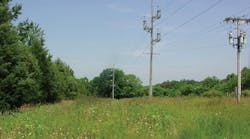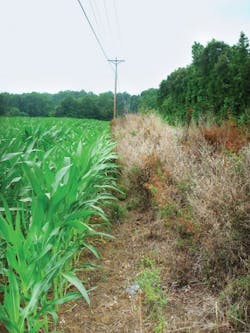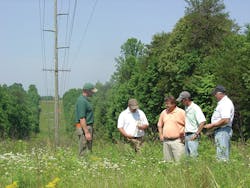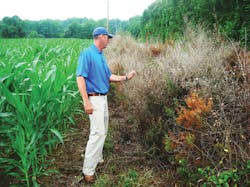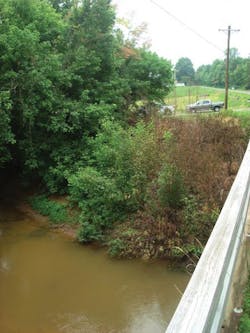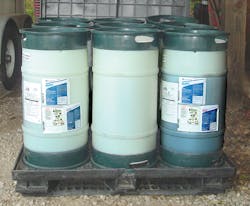It is said that many hands make the work light. This is especially true when those hands are working together toward a common purpose. EnergyUnited, an electric membership cooperative, relies on just 175 employees to maintain 12,500 miles (20,117 km) of lines — including 8,000 miles (12,875 km) of overhead distribution lines and 195 miles (314 km) of overhead transmission lines — that deliver power to 122,000 electricity customers spread out across 19 counties in North Carolina, U.S.
Like many electric cooperatives, the time to dedicate to the important job of vegetation management is limited. That is why, when it comes to using herbicides to manage vegetation on its rights-of-way, EnergyUnited relies on the partnerships it has formed over the years to help with everything from specification to mixing and delivery, all the way through to application and support.
An Effective Herbicide Mix
EnergyUnited has a highly responsive workforce providing safe, reliable and cost-effective service to its members. Its ability to pay close attention to details has paid dividends. The cooperative has a 99.98% reliability record and excellent customer satisfaction scores. The utility knows it helps to have full confidence in the partnerships that have been formed when it comes to vegetation management. And when it comes to vegetation management, herbicides play a big role.
EnergyUnited incorporated herbicides into its vegetation management program in 1990. Since then, herbicide use has expanded as its cost-effectiveness has been realized. Currently, the utility uses a 50-50 mix of herbicide treatments to mechanical treatments to control vegetation on its rights-of-way. EnergyUnited has found using herbicides costs 40% less than straight mechanical methods in terms of overall cost, and the herbicide treatments allow the utility to extend the vegetation management cycles, which is currently every six years.
CWC Chemical Inc. works closely with EnergyUnited on specifying and purchasing its herbicides. In particular, the cooperative wanted to keep it simple when it came to working with herbicides. CWC Chemical devised a single herbicide mix labeled for a wide variety of use sites, but that also would take out the species causing problems on utility’s rights-of-way, including cedar, Virginia pine, sweetgum, locust, kuzdu and bamboo.
A mix of Milestone, Rodeo and imazapyr was specified. It is versatile and pretty much the only mix EnergyUnited uses because it has been very effective in controlling what needs to be controlled. The mix is delivered in 15-gal (57-l) drums with rates of 0.33% Milestone specialty herbicide, 3.75% Rodeo specialty herbicide, 0.5% imazapyr and 0.5% Aqufact adjuvant, mixed with 94.92% water.
Closed-Loop Delivery System
In 2013, EnergyUnited began getting its preferred herbicide mix custom blended and delivered. For that, it turned to Dow AgroSciences’ Continuum Prescription Control & Container Management System and Aqumix Inc.’s packaging and container logistics solution. Combined, this closed-loop delivery system provides custom-blended herbicide mixes in returnable, refillable containers. This solution also eliminates container rinsing and disposal, and reduces container storage and handling requirements, labor costs and accidental exposure to workers. Also important for EnergyUnited was the documentation the system provides.
EnergyUnited and other energy cooperatives have internal controls in place, which is the cornerstone of an effective risk-management program. The Aqumix system identifies each container using a unique drum number and barcode. Aqutrac is the internal operating software, which allows EnergyUnited Internet access to its account. This information provides a complete chain of custody for all of the utility’s herbicide usage and helps the cooperative meet its documentation requirements.
Reporting is also a key feature. This system helps to alleviate public concerns or opposition to herbicide use because everything is well tracked. Some landowners are watching for a stumble or mistake using herbicides. If a complaint is filed, EnergyUnited is able to come back with detailed information on blend and spray reports, down to the specific drum numbers used.
This reporting also is extremely useful when it comes to dealing with recently implemented National Pollutant Discharge Elimination System (NPDES) program regulations. The recent NPDES permit regulations have added another layer of complexity to applying herbicides near water, and water is common when treating power lines. Many times, lines are on private property. There are test tubes with every order from Aqumix, so soil sampling can be performed. The NPDES program requires applicators to keep good records of applications. Failure to do so results in fines.
They say you get what you pay for, and this is an example of that. Everything comes premixed to specifications and ready to use. EnergyUnited can easily record and track everything, which is helpful with landowner complaints and NPDES requirements. On top of it all, Dow AgroSciences provides support if any issues arise.
Responsible Applicators
Many miles of EnergyUnited’s distribution or transmission lines and its respective rights-of-way weave through diverse geography, presenting additional challenges for treating vegetation. The lines cross through pastureland with grazing livestock, around bodies of water, through high-end residential developments and near crop fields planted with everything from corn to more sensitive crops like tobacco. Well-trained and responsible herbicide applicators are needed to avoid running into problems.
EnergyUnited uses contract applicators for all its spray work. Every three to five years, the cooperative bids out the work to area applicators, judging them on three key attributes: reputation, performance and cost. Choosing the correct application partner means the cooperative receives quality workmanship and, in return, fewer complaints. Thus, contractors are chosen carefully. In 2013, EnergyUnited contracted with Top Gun Application Services, LLC.
EnergyUnited also works hard to keep its rights-of-way habitable for native wildlife and plants, especially the several federally endangered plants that are present, including Georgia aster, Michaux’s Sumac and the Schweintz’s sunflower. Furthermore, environmental groups in the area such as the Pollinator Partnership and National Wild Turkey Foundation are looped in on things like creating corridors for wildlife on the floors of the transmission lines.
The cooperative is challenged with providing safe and reliable service to its members while protecting the environment for future generations. Its employees will continue to promote environmental stewardship and be leaders in protecting and enhancing the environment. For EnergyUnited, many hands working together does help make the work light and keeps the lights on for its members.
Acknowledgement
The author would like to thank Luke Kujath, senior account executive with Bader Rutter, for his support in the development of this article, and Ed Schenk, account manager with CWC Chemical, who helped to specify what herbicides are used in vegetation management applications.
Jimmy Brown ([email protected]) is a director of maintenance with EnergyUnited, an electric membership cooperative. His areas of responsibility include vegetation management, fleet services, facilities as well as pole inspection and treatment. He has been with EnergyUnited for more than 37 years. In the operations division, he was part of implementing the cooperative’s first integrated vegetation management program in 1990. He is a licensed herbicide applicator in North Carolina. He has served as the president of the North Carolina Vegetation Management Association and is currently on the North Carolina Pesticide Advisory Committee to the North Carolina Pesticide Division. In 2007, Brown received the North Carolina Wildlife Federation Governor’s Conservation Achievement Award for Land Conservationist of the Year for his work in land stewardship and vegetation management.
Companies mentioned:
Aqumix | www.aqumix.com
CWC Chemical | www.cwc-chemical.com
Dow AgroSciences | www.dowagro.com
EnergyUnited | www.energyunited.com
Sidebar: Tailor Herbicide Mixes to Exact Needs
When administering herbicide treatments, using a properly mixed herbicide solution is crucial to achieving the desired results. A closed-loop container management system provides the ability to tailor a herbicide mix to exact specifications, meaning that when a utility finds a mix that works, it does not have to worry about replicating the mix itself.
Container management systems offer a variety of benefits to users:
• Increase productivity and lowers labor costs
• Reduce responsibility for rinsing, storing or disposing of empty herbicide containers
• Reduce inventory costs drastically with just-in-time shipments and make it easier to manage cash flow, improve inventory tracking and minimize theft liability
• Provide access to detailed information on blend and spray reports
• Reduce landfill waste and liability for improper container disposal
• Decrease the chances of spills and accidental worker exposure.
Recently, the Utility Arborist Association (UAA) published a best management practice study that makes a clear business case for utility adoption of a closed container management system for herbicides. The study, “Best Management Practices for a Closed Chain of Custody for Herbicide Use in the Utility Vegetation Management Industry,” focuses on reducing worker exposure to herbicides, minimizing errors, as well as container recycling and disposal. It also goes into detail on describing practices related to maintaining close connections at transfer points from the producer to the distributor, to the custom blender and to the applicator. Finally, it addresses tank mixing, storage of herbicides and the return of empty containers for reuse.
Best management practices like the use of a closed container management system can help utilities to achieve best-in-class performance and are something with which every vegetation manager should be familiar.The full study findings are available on the UAA website at www.utilityarborist.org.
